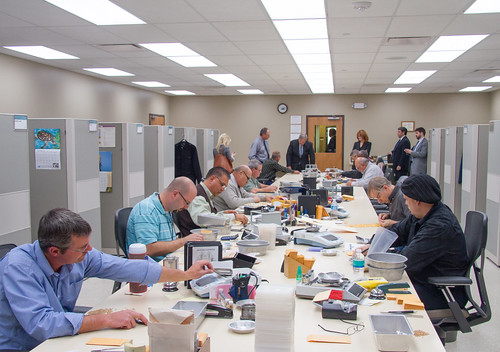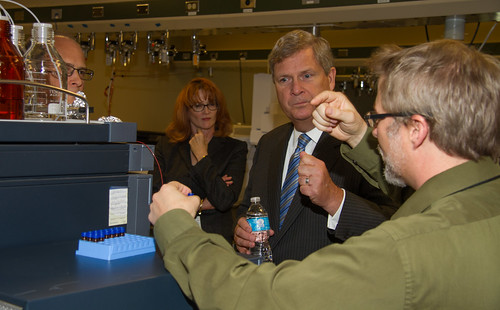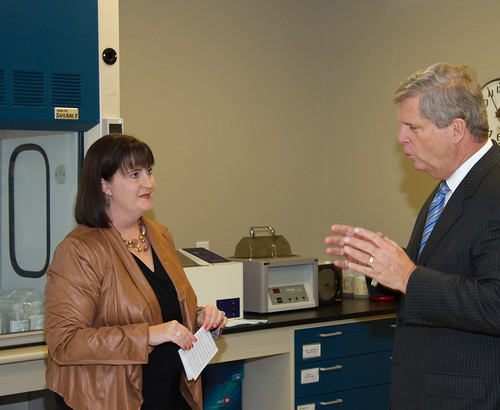
The Grain Inspection, Packers and Stockyards Administration’s (GIPSA) National Grain Center (NGC) was proud to host Agriculture Secretary Tom Vilsack on Wednesday, October 23. The NGC, located in Kansas City, MO, is home to the Federal Grain Inspection Service’s (FGIS) Technology and Science Division along with staff from FGIS’ Quality Assurance and Compliance Division and Field Management Division.
The grain inspectors, scientists and engineers at the NGC provide a broad spectrum of grain inspection services and support within recently renovated state of the art laboratories. During the visit, NGC staff demonstrated how they oversee, develop and approve methods and instruments used for grain inspection that ensure the consistent standard of measuring quality essential to grain marketing.
Members of the Board of Appeals and Review (BAR) and the Grading Services Laboratory (GSL) described their critical role within the grain inspection process. When a grain quality factor is measured through sensory evaluation – how the grain looks or smells – all grain inspectors looking at and smelling the grain sample must be looking for exactly the same thing.

The BAR’s experienced eyes and noses establish the point where a quality factor impacts a grain sample’s overall grade. The GSL monitors the accuracy of individual grain inspection results while the BAR monitors the overall grain inspection results against the BAR’s standard of performance. Both resolve appeals of grain inspection results determined at the initial point of inspection. The BAR’s interpretation is USDA’s final and binding determination.
Equating the process to finding a needle in a haystack, Dr. Tim Norden described how specialized instruments allow his team to analyze grain samples for trace amounts of pesticides and mycotoxins.
The results are often used to confirm that U.S. grain meets international limits for these harmful chemicals. Dr. Norden also emphasized that evolving technology requires that his staff and laboratory constantly maintain their skills.
The NGC’s Biotechnology Laboratory develops and validates methods to identify genetic events in grain. Dr. Tandace Bell, Chief, Biotechnology and Analytical Services Branch, discussed the multi-step process used by her team. Dr. Bell also emphasized the collaborative nature of biotechnology methods development. GIPSA’s Biotechnology Proficiency Program, now in its tenth year, collaborates with over 200 laboratories around the world to ensure their ability to accurately detect genetic events. GIPSA also works closely with other USDA agencies with biotechnology programs.

Test weight and moisture are the most commonly measured quality factors in all types of grain. FGIS has developed a prototype for a training tool to improve inspector skills.
Secretary Vilsack was able to see that technique does indeed make a difference while trying out a test weight trainer being developed by FGIS. The test weight trainer measures a grain inspector’s strike off technique against the approved standard. New and experienced grain inspectors can use it to perfect their technique on this critical measurement.
FGIS approved two instruments to measure moisture in all officially graded commodities over the past year. The Unified Grain Moisture Algorithm (UGMA)-Compatible moisture meters offer improved performance under a wider range of conditions. Dr. Dave Funk, GIPSA’s Chief Scientist, developed the UGMA algorithm that is the basis of the measurement process of the new meters. Dr. Funk recounted the development process, and demonstrated how the two machines offer equivalent results.
The renovated NGC enhances GIPSA’s ability to certify the accuracy and stability of instruments that measure various quality factors in grain.
We all thank Secretary Vilsack for allowing us to show him how the NGC and FGIS support U.S. agriculture.

